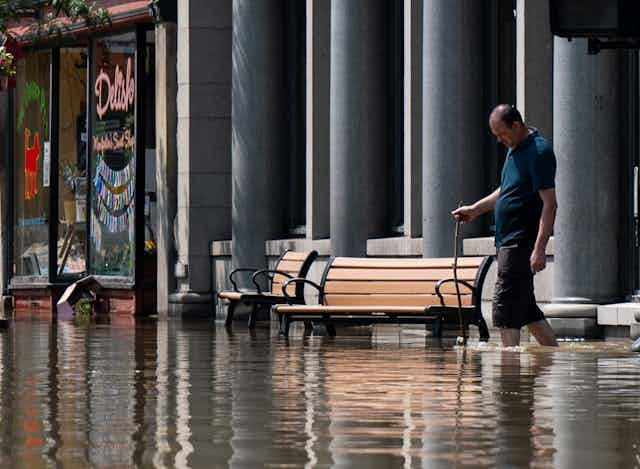National weather analysts released their 2023 billion-dollar disasters list on Jan. 9, just as 2024 was getting off to a ferocious start. A blizzard was sweeping across across the Plains and Midwest, and the South and East faced flood risks from extreme downpours.
The U.S. set an unwelcome record for weather and climate disasters in 2023, with 28 disasters that exceeded more than US$1 billion in damage each.
While it wasn’t the most expensive year overall – the costliest years included multiple hurricane strikes – it had the highest number of billion-dollar storms, floods, droughts and fires of any year since counting began in 1980, with six more than any other year, accounting for inflation.
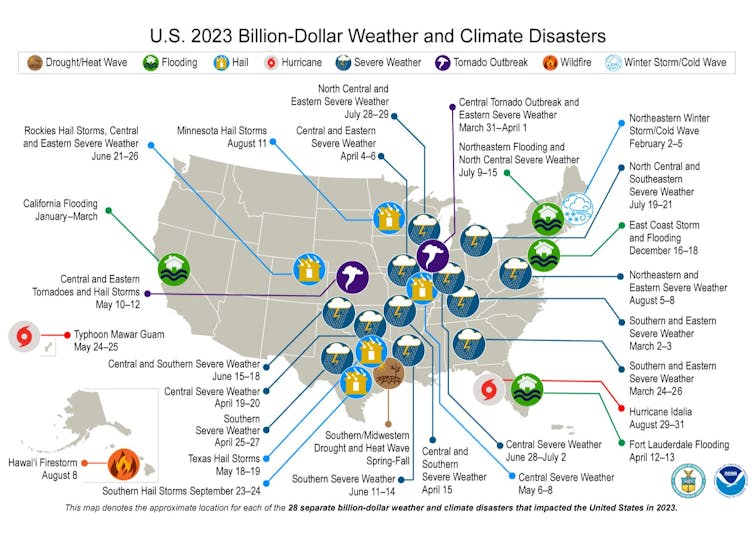
The year’s most expensive disaster started with an unprecedented heat wave that sat over Texas for weeks over the summer and then spread into the South and Midwest, helping fuel a destructive drought. The extreme heat and lack of rain dried up fields, forced ranchers to sell off livestock and restricted commerce on the Mississippi River, causing about US$14.5 billion in damage, according to the National Oceanic and Atmospheric Administration’s conservative estimates.
Extreme dryness in Hawaii contributed to another multi-billion-dollar disaster as it fueled devastating wildfires that destroyed Lahaina, Hawaii, in August.
Other billion-dollar disasters included Hurricane Idalia, which hit Florida in August; floods in the Northeast and California; and nearly two dozen other severe storms across the country. States in a swath from Texas to Ohio were hit by multiple billion-dollar storms.

El Niño played a role in some of these disasters, but at the root of the world’s increasingly frequent extreme heat and weather is global warming. The year 2023 was the hottest on record globally and the fifth warmest in the U.S.
I am an atmospheric scientist who studies the changing climate. Here’s a quick look at what global warming has to do with wildfires, storms and other weather and climate disasters.
Dangerous heat waves and devastating wildfires
When greenhouse gases, such as carbon dioxide from vehicles and power plants, accumulate in the atmosphere, they act like a thermal blanket that warms the planet.
These gases let in high-energy solar radiation while absorbing outgoing low-energy radiation in the form of heat from the Earth. The energy imbalance at the Earth’s surface gradually increases the surface temperature of the land and oceans.
The most direct consequence of this warming is more days with abnormally high temperatures, as large parts of the country saw in 2023.
Phoenix went 30 days with daily high temperatures at 110 F (43.3 C) or higher and recorded its highest minimum nighttime temperature, with temperatures on July 19 never falling below 97 F (36.1 C).
Although heat waves result from weather fluctuations, global warming has raised the baseline, making heat waves more frequent, more intense and longer-lasting.
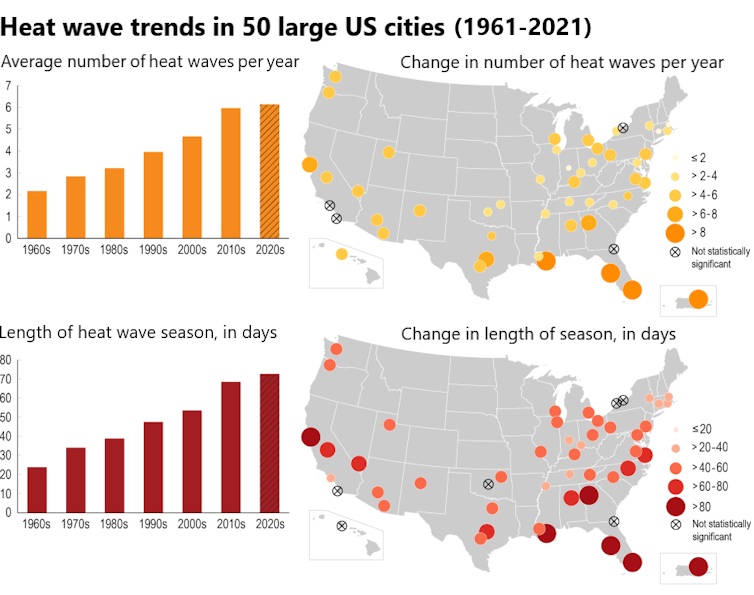
That heat also fuels wildfires.
Increased evaporation removes more moisture from the ground, drying out soil, grasses and other organic material, which creates favorable conditions for wildfires. All it takes is a lightning strike or spark from a power line to start a blaze.
How global warming fuels extreme storms
As more heat is stored as energy in the atmosphere and oceans, it doesn’t just increase the temperature – it can also increase the amount of water vapor in the atmosphere.
When that water vapor condenses to liquid and falls as rain, it releases a large amount of energy. This is called latent heat, and it is the main fuel for all storm systems. When temperatures are higher and the atmosphere has more moisture, that additional energy can fuel stronger, longer-lasting storms.
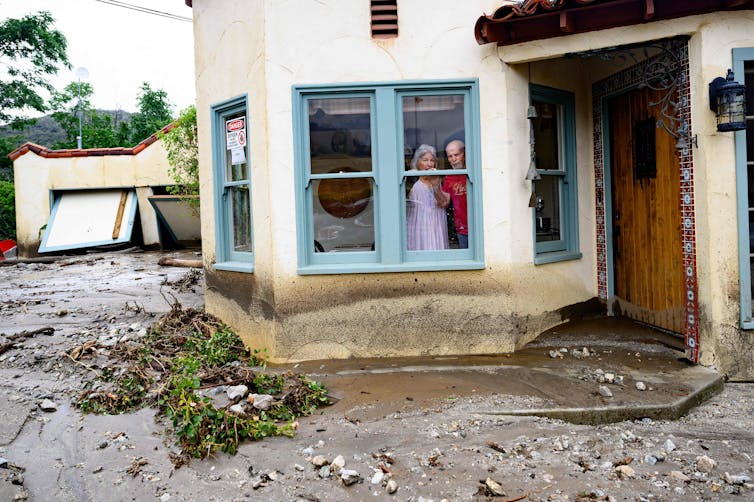
Tropical storms are similarly fueled by latent heat coming from warm ocean water. That is why they only form when the sea surface temperature reaches a critical level of around 80 F (27 C).
With 90% of the excess heat from global warming being absorbed by the ocean, there has been a significant increase in the global sea surface temperature, including record-breaking levels in 2023.
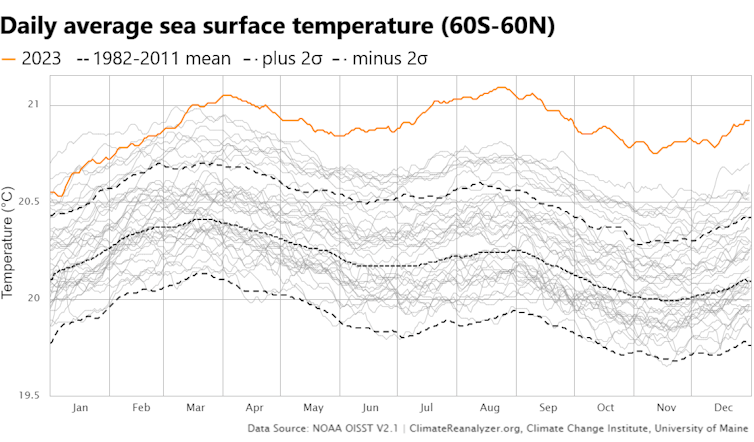
Higher sea surface temperatures can lead to stronger hurricanes, longer hurricane seasons and the faster intensification of tropical storms.
Cold snaps have global warming connections, too
It might seem counterintuitive, but global warming can also contribute to cold snaps in the U.S. That’s because it alters the general circulation of Earth’s atmosphere.
The Earth’s atmosphere is constantly moving in large-scale circulation patterns in the forms of near-surface wind belts, such as the trade winds, and upper-level jet streams. These patterns are caused by the temperature difference between the polar and equatorial regions.
As the Earth warms, the polar regions are heating up more than twice as fast as the equator. This can shift weather patterns, leading to extreme events in unexpected places. Anyone who has experienced a “polar vortex event” knows how it feels when the jet stream dips southward, bringing frigid Arctic air and winter storms, despite the generally warmer winters.
In sum, a warmer world is a more violent world, with the additional heat fueling increasingly more extreme weather events.
This article, originally published Dec. 19, 2023, was updated Jan. 9, 2024, with NOAA’s disasters list.

